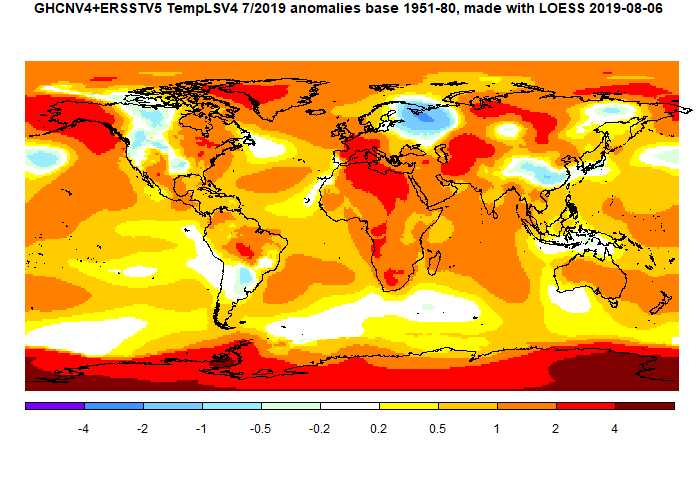The overall pattern was similar to that in TempLS. Hot in Africa and most of Europe, extending into Central Asia. Cool in NW Russia. Coolish in much of N America, but warm in Alaska, extending across Bering Strait. Warm in Greenland, mixed in Antarctica.
As usual here, I will compare the GISS and earlier TempLS plots below the jump.
Here is GISS V4

And here is the TempLS V4 LOESS-based plot

This post is part of a series that has now run for seven years. The GISS data completes the month cycle, and is compared with the TempLS result and map. GISS lists its reports here, and I post the monthly averages here.
The TempLS mesh data is reported here, and the recent history of monthly readings is here. Unadjusted GHCN is normally used, but if you click the TempLS button there, it will show data with adjusted, and also with different integration methods. There is an interactive graph using 1981-2010 base period here which you can use to show different periods, or compare with other indices. There is a general guide to TempLS here.
The reporting cycle starts with a report of the daily reanalysis index on about the 4th of the month. The next post is this, the TempLS report, usually about the 8th. Then when the GISS result comes out, usually about the 15th, I discuss it and compare with TempLS. The TempLS graph uses a spherical harmonics to the TempLS mesh residuals; the residuals are displayed more directly using a triangular grid in a better resolved WebGL plot here.
A list of earlier monthly reports of each series in date order is here:
The TempLS mesh data is reported here, and the recent history of monthly readings is here. Unadjusted GHCN is normally used, but if you click the TempLS button there, it will show data with adjusted, and also with different integration methods. There is an interactive graph using 1981-2010 base period here which you can use to show different periods, or compare with other indices. There is a general guide to TempLS here.
The reporting cycle starts with a report of the daily reanalysis index on about the 4th of the month. The next post is this, the TempLS report, usually about the 8th. Then when the GISS result comes out, usually about the 15th, I discuss it and compare with TempLS. The TempLS graph uses a spherical harmonics to the TempLS mesh residuals; the residuals are displayed more directly using a triangular grid in a better resolved WebGL plot here.
A list of earlier monthly reports of each series in date order is here:












I update my prediction for GISS temperature anomaly using data up to Jul19.
ReplyDeleteGISS.v4
JJA19 0.95+-0.05
SON19 1.03+-0.14
J-D19 0.99+-0.05
DJF20 1.04+-0.21
MAM20 1.09+-0.19
The year 2019 of the GISS LOTI will be most likely the second warmest, only behind 2016.
Assuming the 2019 temperature anomaly the prediction for 2020 is:
with data up to Jun19: J-D20 0.99+-0.15
with data up to Jul19: J-D20 1.02+-0.14
This would be close to a new record.
Note that the result may be less accurate due to still using old MEI values.
Updated my climate index model, with now 9 indices derived from a common forcing: ENSO, QBO, PDO, AMO, IOD, NAO, AO, SAM, PNA
Deletehttps://geoenergymath.com/2019/08/12/ao-pna-and-sam-models/
Dear Nick Stokes,
ReplyDeleteI couldn't find your email address and therefore I'm writing here. I'm trying to understand your trend uncertainty corrections based on ARMA models.
https://moyhu.blogspot.com/2013/09/adjusting-temperature-series-stats-for.html
https://moyhu.blogspot.com/2013/09/uncertainty-of-temperature-trends.html
In these two posts you compare the trend uncertainty using AR(p) and ARMA(1,1) models with global temperature from 1980 to 2013. Strangely, the S.E. is very different. For example, GISS ARMA(1,1) is reported with 0.20°C S.E. in one post, but with 0.11°C in the other post. Do you know why that is the case?
ARMA and other random walk models don't apply when the natural variations are deterministic, see my comment above.
DeleteDear Anon,
DeleteSorry about the late reply. It has taken me a while to get back into that work. I'll write a response tomorrow. Email is nastokes, adding westnet and com and au.